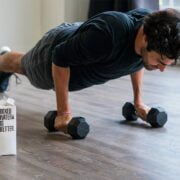
A 30-Minute Morning Workout Routine and Advice
Working out in the morning has numerous benefits for both physical and mental health. Not only does it jumpstart your metabolism and give you an energy boost for the day, but it also sets a positive tone for the rest of your day. In this article, we will explore the benefits of a 30-minute morning workout routine and provide tips and tricks for preparing for your workout, as well as examples of warm-up exercises, cardiovascular exercises, strength training exercises, stretching exercises, and how to create a personalized workout plan. We will also discuss the importance of incorporating mindfulness and meditation into your routine, as well as tips for staying motivated and consistent with your morning workouts. Lastly, we will touch on the importance of proper nutrition and hydration for optimal workout performance.
Key Takeaways
- A 30-minute morning workout routine can provide numerous health benefits.
- Preparing for your morning workout with proper sleep, hydration, and nutrition is crucial.
- Essential warm-up exercises like jumping jacks and lunges can prevent injury and improve performance.
- Cardiovascular exercises like running and jumping rope can provide a high-intensity workout.
- Strength training exercises like push-ups and squats can help build muscle and tone the body.
Benefits of a 30-minute morning workout routine
There are several benefits to working out in the morning. First and foremost, it helps to kickstart your metabolism and get your body burning calories right from the start of the day. This can lead to increased weight loss and improved overall fitness. Additionally, exercising in the morning can help to boost your mood and increase your energy levels throughout the day. It releases endorphins, which are natural mood boosters, and can help to reduce stress and anxiety.
A 30-minute morning workout routine is perfect for those with busy schedules. It allows you to get in a quick and effective workout before starting your day, without taking up too much time. This can be especially beneficial for those who struggle to find time to exercise later in the day due to work or family commitments. By prioritizing your workout in the morning, you ensure that it gets done and set a positive tone for the rest of your day.
Preparing for your morning workout: Tips and tricks
Preparing for a morning workout starts the night before. It’s important to get enough sleep so that you wake up feeling refreshed and energized. Aim for 7-8 hours of sleep each night and establish a consistent sleep schedule. Avoid caffeine and electronic devices before bed, as they can interfere with your sleep quality. Instead, try reading a book or practicing relaxation techniques to help you wind down.
In addition to getting enough sleep, it’s important to have a plan in place for your morning workout. Lay out your workout clothes the night before and have any necessary equipment ready to go. This will make it easier to get started in the morning and eliminate any excuses for not working out. You can also set an alarm or use a fitness app to help you wake up on time and stay motivated.
Essential warm-up exercises to include in your routine
Warming up before your workout is crucial for preventing injury and preparing your body for exercise. It helps to increase blood flow to your muscles, improve flexibility, and enhance your overall performance. Some essential warm-up exercises to include in your routine are:
1. Jumping jacks: Start with your feet together and arms by your sides. Jump up, spreading your feet wider than hip-width apart and raising your arms overhead. Jump back to the starting position and repeat.
2. Arm circles: Stand with your feet shoulder-width apart and extend your arms out to the sides at shoulder height. Make small circles with your arms, gradually increasing the size of the circles. After a few seconds, reverse the direction of the circles.
3. Leg swings: Stand next to a wall or support and hold onto it for balance. Swing one leg forward and backward, keeping it straight. Repeat on the other leg.
4. Hip circles: Stand with your feet shoulder-width apart and place your hands on your hips. Make circles with your hips, rotating them clockwise and then counterclockwise.
Cardiovascular exercises for a high-intensity workout
Cardiovascular exercise is important for improving heart health, increasing endurance, and burning calories. It can be done in a variety of ways, depending on your fitness level and preferences. Some high-intensity cardio exercises to include in your routine are:
1. Running or jogging: This is a great way to get your heart rate up and burn calories. Start with a brisk walk and gradually increase your pace to a jog or run.
2. High-intensity interval training (HIIT): This involves alternating between short bursts of high-intensity exercise and periods of rest or lower intensity exercise. It can be done with any cardio exercise, such as running, cycling, or jumping rope.
3. Jumping rope: This is a fun and effective way to get your heart rate up. Start with a basic jump and gradually increase the intensity by adding in different variations, such as double unders or crisscrosses.
4. Cycling: Whether you prefer indoor cycling on a stationary bike or outdoor cycling, this is a great low-impact cardio exercise that can be tailored to your fitness level.
Strength training exercises for building muscle and toning
Strength training is important for building muscle, increasing bone density, and improving overall strength and stability. It can be done using bodyweight exercises or with the use of weights or resistance bands. Some strength training exercises to include in your routine are:
1. Squats: Stand with your feet shoulder-width apart and lower your body down into a squat position, keeping your knees behind your toes. Push through your heels to return to the starting position.
2. Push-ups: Start in a plank position with your hands slightly wider than shoulder-width apart. Lower your body down towards the ground, keeping your elbows close to your sides. Push back up to the starting position.
3. Lunges: Stand with your feet hip-width apart and take a step forward with one foot. Lower your body down until both knees are at 90-degree angles. Push through your front heel to return to the starting position and repeat on the other side.
4. Plank: Start in a push-up position with your hands directly under your shoulders. Engage your core and hold the position for as long as you can, keeping your body in a straight line from head to toe.
Stretching exercises to improve flexibility and prevent injury
Stretching is important for improving flexibility, preventing injury, and reducing muscle soreness. It should be done after your workout, when your muscles are warm. Some stretching exercises to include in your routine are:
1. Standing hamstring stretch: Stand with your feet hip-width apart and extend one leg out in front of you, resting it on a chair or bench. Hinge forward at the hips, keeping your back straight, until you feel a stretch in the back of your leg. Hold for 30 seconds and repeat on the other side.
2. Chest stretch: Stand with your feet shoulder-width apart and interlace your fingers behind your back. Squeeze your shoulder blades together and lift your arms up, feeling a stretch in your chest. Hold for 30 seconds.
3. Quadriceps stretch: Stand with your feet hip-width apart and lift one foot up towards your glutes, grabbing onto it with your hand. Keep your knees close together and push your hips forward slightly to deepen the stretch. Hold for 30 seconds and repeat on the other side.
4. Child’s pose: Start on all fours and sit back onto your heels, reaching your arms forward and resting your forehead on the ground. Relax into the stretch and take deep breaths.
How to create a personalized workout plan for your fitness level
Creating a personalized workout plan is important for ensuring that you are challenging yourself appropriately and making progress towards your fitness goals. Here are some tips for creating a personalized workout plan:
1. Assess your current fitness level: Take note of your current fitness level and any limitations or injuries you may have. This will help you determine what exercises and intensity levels are appropriate for you.
2. Set specific goals: Determine what you want to achieve with your workouts, whether it’s weight loss, muscle gain, or improved endurance. Set specific goals that are realistic and achievable.
3. Choose exercises that you enjoy: Find exercises that you enjoy doing, as this will make it more likely that you stick to your workout plan. Mix up your routine to keep things interesting and prevent boredom.
4. Gradually increase intensity: Start with exercises and intensity levels that are appropriate for your fitness level and gradually increase the intensity as you get stronger and more comfortable.
Incorporating mindfulness and meditation into your morning workout routine
Incorporating mindfulness and meditation into your morning workout routine can help to enhance the mind-body connection and improve overall well-being. It can also help to reduce stress and increase focus during your workouts. Here are some tips for incorporating mindfulness and meditation into your routine:
1. Start with a few minutes of deep breathing: Before you begin your workout, take a few minutes to sit quietly and focus on your breath. Take slow, deep breaths in through your nose and out through your mouth, focusing on the sensation of the breath entering and leaving your body.
2. Practice mindfulness during your workout: Instead of letting your mind wander or getting caught up in distractions, try to stay present and focused on the sensations in your body as you move through your workout. Pay attention to how each movement feels and the muscles that are being engaged.
3. End with a short meditation: After your workout, take a few minutes to sit quietly and reflect on the experience. Close your eyes and bring your attention back to your breath, allowing any thoughts or distractions to come and go without judgment.
Tips for staying motivated and consistent with your morning workouts
Staying motivated and consistent with your morning workouts can be challenging, especially when you’re tired or pressed for time. Here are some tips to help you stay on track:
1. Set realistic goals: Set realistic goals that are achievable and break them down into smaller, more manageable steps. Celebrate your progress along the way to stay motivated.
2. Find an accountability partner: Find a workout buddy or join a fitness group to help keep you accountable and motivated. Knowing that someone else is counting on you can make it easier to stick to your routine.
3. Mix up your routine: Keep your workouts interesting by trying new exercises or classes. This will prevent boredom and keep you motivated to continue.
4. Reward yourself: Set up a reward system for yourself, such as treating yourself to a massage or buying a new workout outfit when you reach a certain milestone or achieve a goal.
The importance of proper nutrition and hydration for optimal workout performance
Proper nutrition and hydration are essential for optimal workout performance and recovery. Before your morning workout, it’s important to fuel your body with the right nutrients to give you energy and support muscle growth. Here are some tips for fueling your body before and after your morning workout:
1. Eat a balanced meal or snack before your workout: Aim to eat a combination of carbohydrates, protein, and healthy fats before your workout to provide sustained energy. Some examples include a banana with nut butter, Greek yogurt with berries, or a protein smoothie.
2. Stay hydrated: Drink water before, during, and after your workout to stay hydrated. If you’re doing a longer or more intense workout, consider adding electrolytes to your water or drinking a sports drink.
3. Refuel after your workout: After your workout, it’s important to replenish your glycogen stores and provide your muscles with the nutrients they need to recover. Aim to eat a combination of carbohydrates and protein within 30 minutes to an hour after your workout. Some examples include a turkey and avocado wrap, a chicken and vegetable stir-fry, or a protein shake with fruit.
In conclusion, a 30-minute morning workout routine can have numerous benefits for both physical and mental health. It can help to jumpstart your metabolism, boost your mood, and increase your energy levels throughout the day. By incorporating warm-up exercises, cardiovascular exercises, strength training exercises, stretching exercises, mindfulness and meditation practices, and proper nutrition and hydration into your routine, you can maximize the benefits of your morning workouts. Remember to listen to your body, set realistic goals, and stay consistent to achieve long-term success. So why not give it a try? Set your alarm a little earlier tomorrow and start reaping the benefits of a morning workout routine.
Looking for more fitness inspiration? Check out this article on Wave Magnets, a website dedicated to helping individuals achieve their health and wellness goals. One of their informative posts is a sample page that provides valuable insights into creating a 30-minute morning workout routine and offers expert advice on how to make the most out of your exercise sessions. Whether you’re a beginner or a seasoned fitness enthusiast, Wave Magnets has got you covered with their comprehensive resources and tips. Click here to read more and start your journey towards a healthier lifestyle.
FAQs
What is a 30-minute morning workout routine?
A 30-minute morning workout routine is a set of exercises that can be completed in 30 minutes or less, typically done in the morning to kickstart the day.
What are the benefits of a 30-minute morning workout routine?
A 30-minute morning workout routine can help improve physical fitness, boost energy levels, reduce stress, improve mood, and increase productivity throughout the day.
What exercises can be included in a 30-minute morning workout routine?
Exercises that can be included in a 30-minute morning workout routine include cardio exercises such as running or jumping jacks, strength training exercises such as push-ups or squats, and stretching exercises such as yoga or Pilates.
How often should a 30-minute morning workout routine be done?
A 30-minute morning workout routine can be done daily or a few times a week, depending on personal fitness goals and schedules.
What advice should be followed when starting a 30-minute morning workout routine?
When starting a 30-minute morning workout routine, it is important to start slowly and gradually increase intensity, stay hydrated, wear appropriate workout clothing and shoes, and listen to your body to avoid injury. It is also recommended to consult with a healthcare professional before starting any new exercise routine.


















